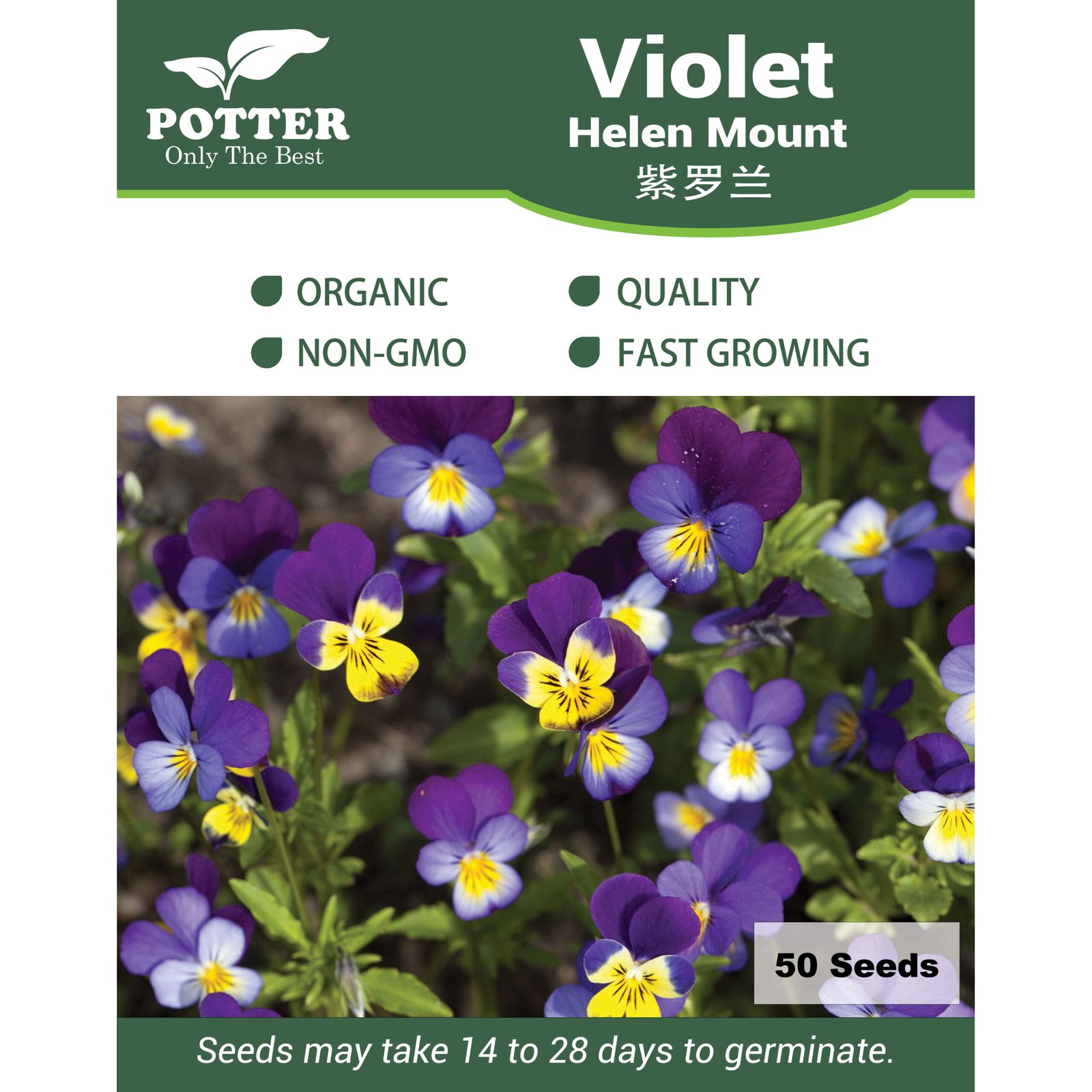Sowing Violet Seeds A Comprehensive Guide to Cultivating Enchanting Violet Blooms
The beauty of violets, with their velvety petals and delicate fragrance, has captivated gardeners and enthusiasts alike for centuries. Whether you desire a vibrant splash of color in your garden or a soothing addition to your indoor decor, violets offer an enchanting charm that few flowers can match. Sowing violet seeds is a rewarding experience that allows you to witness the transformation of tiny seeds into flourishing blooms. This comprehensive guide will guide you through every step, from choosing the right violet seed varieties to providing the necessary care for their successful growth.
Embracing Violet Beauty: Exploring Different Violet Seed Variants

Violets belong to the genus Viola, which includes over 500 species of flowering plants. While there are many different types of violets, some are more commonly used for gardening purposes than others. Here are some of the most popular violet species and their unique characteristics:
Common Violet Species:
- Pansies (Viola tricolor): With their cheerful faces and vibrant hues, pansies grace gardens with their charm. They are popular for their ability to thrive in various conditions and their versatility in landscaping. Pansies come in a wide range of colors, including purple, yellow, orange, and white, making them a popular choice for adding a pop of color to any garden.
- Violets (Viola odorata): Known for their sweet fragrance and delicate petals, violets are often used in perfumes, cosmetics, and culinary creations. These shade-loving blooms add a touch of elegance to any garden. Violets come in shades of purple, blue, and white, and are known for their heart-shaped leaves.
- Bird's Foot Violet (Viola pedata): This native North American species is named for its unique leaves that resemble a bird's foot. It produces small, delicate purple flowers and is often used in rock gardens or as a groundcover.
- Canada Violet (Viola canadensis): This hardy violet species is native to North America and produces clusters of deep purple flowers. It is a popular choice for woodland gardens and can tolerate a wide range of soil conditions.
- Dog Violet (Viola riviniana): Also known as the common blue violet, this species is native to Europe and Asia but has been naturalized in North America. It produces small, fragrant purple flowers and is a favorite among pollinators.
- Horned Violet (Viola cornuta): This European species is known for its distinctive horn-like petals and comes in shades of purple, blue, and white. It is a popular choice for borders and containers.
- English Violet (Viola riviniana): Similar to the dog violet, this species is also native to Europe and produces fragrant purple flowers. It is often used in cottage gardens and can tolerate partial shade.
- California Golden Violet (Viola pedunculata): This West Coast native produces bright yellow flowers and is often used in meadow plantings or as a groundcover.
- American Dog Violet (Viola labradorica): This North American species produces deep purple flowers and is often used in rock gardens or as a border plant.
- Himalayan Violet (Viola biflora): This Asian species produces delicate white flowers with purple markings and is a popular choice for woodland gardens.
- Marsh Blue Violet (Viola cucullata): As the name suggests, this species thrives in wet, marshy areas and produces large, showy purple flowers.
- Confederate Violet (Viola sororia 'Freckles'): This cultivar of the common blue violet features unique white flowers with purple speckles. It is a popular choice for adding interest to borders and containers.
- Cream Violet (Viola striata): This North American species produces delicate cream-colored flowers with purple veins and is often used in rock gardens or as a groundcover.
- Downy Yellow Violet (Viola pubescens): This North American species produces bright yellow flowers and is often used in woodland gardens or as a border plant.
- Tufted Pansy Violet (Viola × wittrockiana): A hybrid of several different violet species, this cultivar produces large, showy flowers in a wide range of colors and is a popular choice for containers and borders.
Choosing the Right Violet Seeds:
When it comes to choosing the right violet seeds, there are a few factors to consider. Here are some tips to help you select the perfect violet seeds for your garden:
Consider the Color Palette:
Violets come in a kaleidoscope of colors, from deep purples and blues to soft pinks and whites. Choose seed varieties that suit your personal preferences and the overall theme of your garden. If you want a more cohesive look, stick to one color family or choose complementary colors for a striking contrast. You can also mix and match different violet varieties to create a vibrant and diverse display.
Know Your Growing Conditions:
Different violet species have varying requirements when it comes to sunlight, soil, and water. Some prefer full sun, while others thrive in partial shade. Make sure to read the seed packet or do some research on the specific needs of the violet species you are interested in before making your purchase. This will ensure that your violets have the best chance of thriving in your garden.
Planting Violet Seeds:

Now that you have chosen your desired violet seed varieties, it's time to start planting! Here is a step-by-step guide on how to plant violet seeds:
Step 1: Choose the Right Time:
The best time to sow violet seeds is in the early spring or late summer. This will give the seeds enough time to germinate and establish before the harsh temperatures of summer or winter arrive.
Step 2: Prepare the Soil:
Violets prefer well-draining soil that is rich in organic matter. If your soil is heavy or clay-like, consider adding some compost or peat moss to improve drainage. You can also mix in some slow-release fertilizer to provide nutrients for your violets as they grow.
Step 3: Sow the Seeds:
Violet seeds are tiny, so it's important to handle them with care. You can either sprinkle the seeds directly onto the prepared soil or start them indoors in seed trays. If you choose to start them indoors, make sure to use a sterile potting mix and keep the soil consistently moist until the seeds germinate.
If sowing directly into the ground, gently press the seeds into the soil, making sure not to bury them too deep. A good rule of thumb is to cover the seeds with a thin layer of soil that is equal to the size of the seed.
Step 4: Water and Mulch:
After sowing the seeds, water the soil thoroughly but gently. Avoid using a strong stream of water, as this can displace the seeds. Once the soil is moist, add a layer of mulch to help retain moisture and prevent weeds from growing.
Step 5: Provide Adequate Care:
Violet seeds require consistent moisture to germinate and establish, so make sure to water them regularly. Once the plants have grown a few inches tall, you can reduce watering to once or twice a week, depending on your climate. Violets also benefit from a light application of fertilizer every few weeks to promote healthy growth.
Caring for Violet Seedlings:

Once your violet seeds have germinated and grown into seedlings, it's important to continue providing them with the necessary care to ensure their successful growth. Here are some tips for caring for your violet seedlings:
Watering:
Violet seedlings require consistent moisture to thrive, so make sure to water them regularly. Avoid overwatering, as this can lead to root rot. Instead, check the soil moisture level before watering and adjust accordingly.
Fertilizing:
As mentioned earlier, violets benefit from regular fertilization. You can use a balanced fertilizer or one specifically formulated for flowering plants. Follow the instructions on the fertilizer package for the best results.
Pruning:
To encourage bushier growth, you can pinch off the top of the main stem of your violet seedlings once they reach a few inches tall. This will promote the growth of side shoots and result in a fuller plant.
Transplanting:
If you started your violet seeds indoors, you will need to transplant them into larger containers or into your garden once they outgrow their seed trays. Make sure to handle the delicate seedlings with care and avoid damaging their roots.
Common Issues and Solutions:
While violets are relatively easy to grow, they can still face some common issues. Here are some problems you may encounter and how to solve them:
Powdery Mildew:
This fungal disease appears as a white powdery coating on the leaves of your violets. It is caused by high humidity and poor air circulation. To prevent powdery mildew, make sure to space your plants properly and avoid getting water on the leaves when watering. If your violets do get infected, you can treat them with a fungicide or remove the affected leaves.
Aphids:
These small, soft-bodied insects can suck the sap from your violet plants, causing stunted growth and distorted leaves. To get rid of aphids, you can spray your plants with a mixture of water and dish soap or use an insecticidal soap.
Slugs and Snails:
These slimy pests can munch on the leaves and flowers of your violets, leaving behind holes and damage. You can handpick them off your plants or use slug pellets to deter them.
Conclusion:

Sowing violet seeds is a rewarding experience that allows you to witness the beauty of nature firsthand. By choosing the right violet seed varieties and providing them with the necessary care, you can enjoy a stunning display of colorful blooms in your garden or home. Remember to be patient and consistent in your care, and soon you will be rewarded with enchanting violet blooms that will bring joy and beauty to your surroundings. Happy planting!


Leave a comment